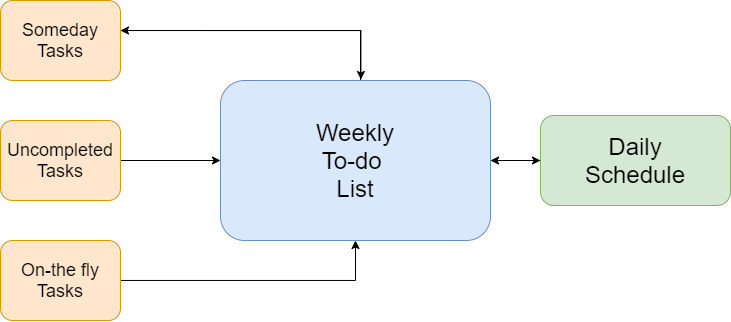Time Management Course
Chapter II
Basic Time Management Concepts

Course structure
DAY 1
Foreword
Study tips
Course schedule (proposal)
Workload Estimator
Daily Worksheet
Resources
DAY 2
Introductory notes
Module 1 – Goal setting
The importance of setting goals
Goals and objectives
Make your goals S.M.A.R.T.
Weekly goals
Practice materials
Decision matrix
How to use the decision matrix
Practice materials
DAY 3
To-do list
Calendar
Someday tasks
Practice materials
DAY 4
Time blocking
SWDH
Practice materials
DAY 5
What time should you be tracking?
Time tracking process
Invoicing your billable hours
Module 6 – Time accountability
Use the calendar to keep yourself on track
Keep track of your daily routine
Leave no task behind
Practice materials
DAY 6
Efficient versus effective
To bear in mind / follow
To avoid
Additional materials
DAY 7
A quick recap of key concepts
Self-Assessment
Additional resources
Module 4 – Advanced planning techniques
In terms of planning, in this module, we’ll show you two ways to improve both the efficiency of your planning process and the results you get from it.
The two advanced planning techniques presented will help you in a simple and effective way to:
- create a plan that is actionable, effective, and measurable and that allows you to stay focused on what you want to achieve;
- consider all options and set a flexible schedule so you can easily choose the most effective approach to adapt if circumstances change;
- make a clear and concise plan with simple steps that you can easily follow;
- set realistic timelines, taking into account factors such as available resources, competing priorities, and potential obstacles so you can progress as expected;
- track your progress to determine if the plan is working or if adjustments need to be made to stay on track.
Time blocking
This technique can be applied as a general rule in both long-term planning and especially short-term planning.
As the name says, the technique consists of reserving time intervals for each activity you have to do. You will not do this by chance, but by respecting some basic principles that we list below.
Prepare your to-do list, estimating the time required for each item, and prioritize them according to the technique learned in CHAPTER II Module 2 Prioritization.
Set your schedule by selecting those time blocks in the calendar and keeping buffer-time slots between them for breaks or unforeseen events.
As you process and complete certain activities, mark them in a distinct way so you can see the status of your schedule at a glance.
Using the time blocking technique, you can, for example, reserve the time required for all morning activities under the generic name of “Morning routine.”
In this case, you no longer have to detail the activities one by one, but you know that in the selected interval you have to complete your morning activities, which might include showering, brushing your teeth, freshening up, having breakfast, and getting appropriately dressed for the activities to be carried out.
In a similar way, you can proceed with lunch or dinner, going to the gym, or following the evening routine, especially if you respect the same time intervals every day.
This way, you will see at a glance what time slots are available for the other activities you have to complete. In addition, you can ensure that you do not give up personal activities in favor of professional ones. We know from our own experience that when you have a lot to do, you are tempted to extend your work schedule and skip the gym.
Later, as you carry out the activities, if you have free time between them, you can re-organize them so you can make the most of each moment, exactly as you want.
Time blocks can be moved very simply with drag&drop, and the size of the time interval can be easily edited directly on the calendar by re-sizing the respective task box.
Time blocking is a great way to manage your time and stay on track. It can also be done on paper or spreadsheets, so you can choose the format that works best for you.
SWDH
The acronym comes from “Someday – Week – Day – Hour” and it works as a system to improve personal productivity.
SWDH is based on the week time frame because we naturally make many of our plans by thinking in terms of weeks – for example, “I’m going on vacation for two weeks,” “This week I have a lot of things to do,” and “Next week I have to find time for the theater.” Therefore, you can apply this technique very easily because it perfectly adapts to the way you are used to working.
In addition, this means of structuring activities helps us when we break down the main goals into intermediate objectives to be achieved. It is more difficult to keep track of everything you have to do in a month and to remember which of the objectives you have achieved and which you have not. However, when you do this weekly, it is very easy to stay on top of everything regarding your busy schedule.,/
You will always know the deadlines and you will not forget activities. You will always know what you have to do and when, as well as the free time you have available.
How does SWDH work?
You will start by building your weekly to-do list containing all the activities to complete in the following week.

If there are activities that you know, from the start, that you have to do in two, three, or more weeks, create separate lists for them.
Later, from the weekly list, select the activities according to priorities and distribute them by day.
You can add new activities to the weekly list at any time, and you can plan the existing ones “on the fly” as needed.
If something remains undone, you can easily identify it because it will remain in the weekly list. You can include it, as you see fit, in your to-do list for the following week or any other week.
What supports can you use SWDH on?
Depending on your preferences, you can apply the SWDH technique on paper, in Excel, or in an online application.
SWDH on paper
On paper, you will need a notebook or an agenda that you can structure as follows:
- On the first page, write down all the activities of the week.
- Allocate the second page to Monday, Tuesday, and Wednesday. From the first page, take the activities you want to do on these days, writing them down next to the corresponding day.
- Assign the third page to Thursday, Friday, Saturday, and Sunday and proceed similarly to the previous step, taking the activities for these days from the weekly list.
- Repeat this structure for each of the 52 weeks of the year.
In this case, keep in mind that the planning of each week with the corresponding breakdown will require at least three pages.
SWDH in Excel
To apply SWDH in Excel, you can use the template we provide. Create the weekly list in the first column and then, depending on your priorities, distribute the list items in the columns that represent the days of the week.
SWDH in an app
Directly in the calendar, select the days of the week for which you want to prepare the list. In the to-do item that was created, list all the activities related to that week. You can do this for any week you want and for any group of days in that week.
Later, from your weekly to-do list, select the activities and distribute them by day according to priorities. Automatically, they will be transferred from the weekly list on the specified day and time.
You can juggle these plans as needed directly in the calendar with drag&drop. Including the duration, you can make changes simply by dragging the edge of the task with the mouse. This is extremely useful for adjusting your schedule so you can easily adapt to unforeseen situations.
If you have planned an activity for a certain time but can’t do it then and have to reschedule it, and if you haven’t decided when, you can place it back in the weekly list. Simply use the “Merge” function and select the item in which you want it included.
It will be retrieved with all its details (Client, Project, Activity), and when you want to reschedule it, it will automatically be retrieved again. In the video below, we show you how easily a task can be rescheduled.
Practice for Advanced Planning Techniques
To practice the two advanced planning techniques, we propose the following exercises.
Practice for time blocking
Think about what you want to do the following weekend and apply the time blocking method. Even if you don’t have exact plans, apply this method to everyday activities such as your morning and evening routine, lunch, visiting your parents, or preparing dinner.
Practice for SWDH
For this stage, we suggest that you create your weekly to-do list for the following week. Don’t worry if you don’t know all the activities you want to complete yet. As you already know, the list can be easily edited at any time. You can add or remove elements from it exactly as you need. Therefore, use this exercise to familiarize yourself with the technique. Later, you can edit the recordings made as you wish.
You can perform this exercise by following, step by step, the examples in the videos above.




